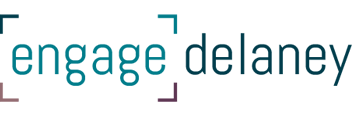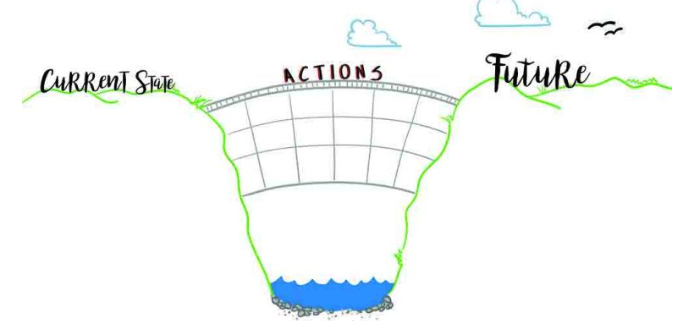Technique Focus – The Bridge
By Jessica Delaney, Principal – Engagement + Communications, at Engage Delaney, and Tanya Gadsby, Creative Director + Graphic Facilitator, at Fuselight
A few years ago, I was helping a client with mapping for strategic planning. Where were they and where did they want to go? Tanya is a graphic facilitator at Fuselight Creative, and she took my engagement objectives and translated them into a user-friendly template called the bridge.
Here were my engagement objectives:
- To gather information from staff on their ideal future state for the organization.
- To explore and document with staff how their ideal future would be measured.
- To develop a baseline of the staff’s current perceptions of their organization, both positive and negative.
- To collaborate on identifying the necessary action required to achieve the ideal future state.
Additional objectives that could be achieved using the bridge include identifying opportunities (in the clouds) and threats (in the water below) that could either be leveraged or need to be mitigated. We kept the design clean and simple so people wouldn’t feel intimidated to write directly on the template.
Typically, I start using the bridge on the right-hand side with the ideal future state. This gets people thinking in the positive and affirmative. I also tend to prioritize spending time here, potentially 30 minutes or more. I then move to the current state and would spend only a 1/3 the time I did in the future state, so potentially 10 minutes. The idea here is to get insights about the current state that you can’t get from other data sources.
The next step is to move to the actions in the bridge. Here you might spend up to 30 minutes or more mapping what needs to be done to achieve the ideal future state. It is important to clarify who is taking the action: will it be staff, or the executive, or stakeholders?
After those first three areas of the template are completed and based on your objectives, I would then turn to opportunities, threats and measures.
D+A and Fuselight want to help support a better process, so if you are interested in the template, please download it here. We typically print it in a large format (10×4 feet), but you can use it in any size and you can even print it in legal size and ask people to reflect on their ideas before the whole group workshop.
A few tips:
- It is best to have this as a facilitated technique
- It is important to keep track of time
- It is important that the question and project are clear. For example: we are developing a strategic plan and we need staff’s input to help inform the broader strategy.
- We typically have groups between 8 to 25 people participate in this technique and have done multiple concurrent sessions. We’ve used this template simultaneously with over 200 people!
- You can leverage this template with dot voting or Feedback frames to truly prioritize within each bridge and then have participants bring forward their top ideas to the larger group.
Have fun with it and people share your stories about how this template has helped your engagement process.




